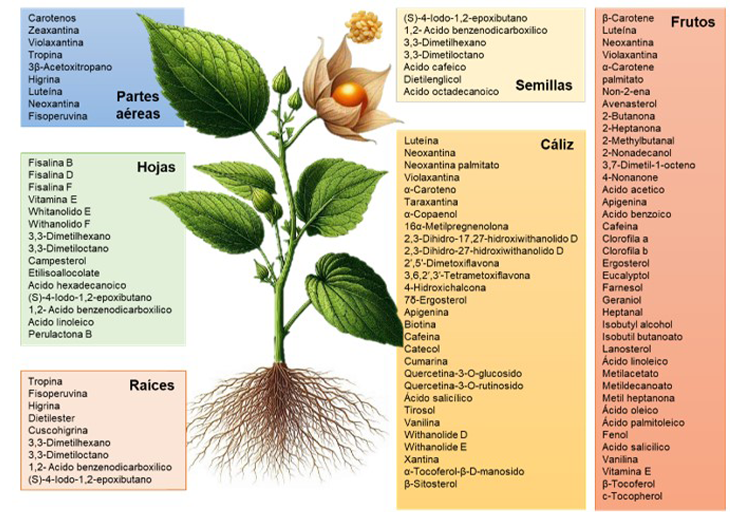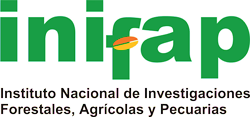Goldenberry L.: phytochemicals and applications in human health
DOI:
https://doi.org/10.29312/remexca.v16i5.3682Keywords:
Physalis peruviana, phytochemicals, nutrition, health benefitsAbstract
Goldenberry is a species of great socioeconomic importance in different countries of Latin America and Africa. At the phytochemical level, this species presents a variety of biologically important phytochemicals. Therefore, this paper aims to provide an exhaustive summary of Physalis peruviana goldenberry, focusing on its phytochemicals and applications in human health. This work was conducted in 2024; it indicates that, at the level of its fruits, there are terpenes, phenolic compounds, alcohols, steroids, withanolides, highlighting carotenoids and flavonoids, reduced levels of fat, high water content and vitamins A, B3, B6, C and E, as well as the minerals calcium, potassium, phosphorus and magnesium. This richness in phytochemicals and nutrients of goldenberry translates into significant health benefits thanks to its antioxidant, antibacterial and antiproliferative properties. In particular, goldenberry calyxes and leaf extracts have demonstrated antihepatotoxic, antifibrotic and antidiabetic activity. In summary, the goldenberry has an optimal nutritional content and it is necessary to optimize the bioavailability of its components to fully take advantage of its benefits. Due to its potential as a promising component in functional foods and phytomedicine, there is a need for more in-depth evaluations of its impact on the well-being of humanity.
Downloads
References
Arun, M. and Asha, V. V. 2007. Preliminary studies on antihepatotoxic effect of Physalis peruviana Linn. (Solanaceae) against carbon tetrachloride induced acute liver injury in rats. J. Ethnopharmacol. 111(1):110-114. Doi:10.1016/j.jep.2006.10.038.
Asilbekova, D. T.; Ul’chenko, N. T. and Glushenkova, A. I. 2016. Lipids from Physalis alkekengi. Chemistry of Natural Compounds. 52(1):96-97. Doi:10.1007/s10600-016-1556-0.
Ballesteros-Vivas, D.; Alvarez-Rivera, A.; Sánchez, C. A.; Ibañez, E.; Parada-Alfonso, F. and Cifuentes, A. 2019. A multi-analytical platform based on pressurized-liquid extraction, in vitro assays and liquid chromatography/gas chromatography coupled to high resolution mass spectrometry for food by-products valorisation. Part 1: whitanolides-rich fractions from goldenberry (Physalis peruviana L.) calyces obtained after extraction optimization as case study. Journal of Chromatography A. 1584(1):155-164. Doi:10.1016/j.chroma.2018.11.055.
Bazalar, M. S.; Nazareno, M. A. and Viturro, C. I. 2019. Nutritional and antioxidant properties of Physalis peruviana l. fruits from the Argentinean northern Andean region. Plant Foods for Human Nutrition. 74(1):68-75. Doi:10.1007/s11130-018-0702-1.
Carazo, A.; Macáková, K.; Matoušová, K.; Krčmová, L. K.; Protti, M. and Mladěnka, P. 2021. Vitamin A update: forms, sources, kinetics, detection, function, deficiency, therapeutic use and toxicity. Nutrients. 13(5):1703-1739. Doi: 10.3390/nu13051703.
Chasquibol, N. A. and Yácono, J. C. 2015. Composición fitoquímica del aceite de las semillas del fruto del ‘aguaymanto’, Physalis peruviana L. Revista de la Sociedad Química del Perú. 81(1):311-318. http://www.scielo.org.pe/pdf/rsqp/v81n4/a03v81n4.pdf.
Chiu, C. C.; Haung, J. W.; Chang, F. R.; Huang, K. J. and Huang, H. M. 2013. Golden berry-derived 4⊎-hydroxy whitanolide E for selectively killing oral cancer cells by generating ROS, DNA damage, and apoptotic pathways. PLoS One. 8(5):e64729. Doi:10.1371/journal.pone.0064739.
Cicchetti, E.; Duroure, L.; Borgne, E. and Laville, R. 2018. Upregulation of skinaging biomarkers in aged NHDF cells by a sucrose ester extract from the agroindustrial waste of Physalis peruviana calyces. Journal of Natural Products. 81(1):1946-1955. Doi:10.1021/acs.jnatprod.7b01069.
Cortés-Díaz, G.; Prieto, G. A. and Rozo, W. E. 2015. Bromatological and physicochemical characterization of Physalis peruviana L., and its potential as a nutraceutic food. Ciencia en Desarrollo. 20(1):87-97. Doi:10.19053/01217488.3653.
Eken, A.; Ünlü-Endirlik, B.; Baldemir, A.; İlgün, S.; Soykut, B. and Erdem, O. 2016. Antioxidant capacity and metal content of Physalis peruviana L. fruit sold in markets. Journal of Clinical and Analytical Medicine. 7(3):291-294. Doi:10.4328/jcam.2709.
Etzbach, L.; Pfeiffer, A.; Weber, F. and Schieber, A. 2018. Characterization of carotenoid profiles in goldenberry (Physalis peruviana L.) fruits at various ripening stages and in different plant tissues by HPLC-DAD-APCI-MS. Food Chemistry. 245(1):508-517. Doi: 10.1016/j.foodchem.2017.10.120.
Fan, H.; Huang, W.; Guo, Y.; Ma, X. and Yang, J. 2022. α-Linolenic acid suppresses proliferation and invasion in osteosarcoma cells via inhibiting fatty acid synthase. Molecules. 27(9):2741-2754. Doi:10.3390/molecules27092741.
Franco, L. A.; Matiz, G. E.; Calle, J.; Pinzón, R. and Ospina, L. F. 2007. Actividad antinflamatoria de extractos y fracciones obtenidas de cálices de Physalis peruviana L. Biomedica. 27(1):110-115. Doi:https://doi.org/10.7705/biomedica.v27i1.237.
Huang, M.; He, J. X.; Hu, H. X.; Zhang, K.; Wang, X. N.; Zhao, B. B. and Shen, T. 2020. Whitanolides from the genus Physalis: a review on their phytochemical and pharmacological aspects. The Journal of Pharmacy and Pharmacology. 72(5):649-669. Doi: 10.1111/jphp.13209.
Janardhanan, R. and Sathyavathi, R. 2014. Wild edible fruits used by Badagas of Nilgiri District, Western Ghats, Tamilnadu, India. Journal of Medicinal Plants Research. 8(1):128-132. Doi:10.5897/jmpr11.445.
Kasali, F. M.; Tusiimire, J.; Kadima, J. N.; Tolo, C. U.; Weisheit, A. and Agaba, A. G. 2021. Ethnotherapeutic uses and phytochemical composition of Physalis peruviana L.: an overview. The Scientific World Journal. 1:1-22. Doi:10.1155/2021/5212348.
Lan, Y. H.; Chang, F. R.; Pan, M. J.; Wu, C. C. Wu, S. J. and Chen, S. L. 2009. New cytotoxic whitanolides from Physalis peruviana. Food Chemistry. 116(1):462-469. Doi.org/10.1016/j.foodchem.2009.02.061.
Lee, Y. J.; Lee, M.; Wi, Y. M.; Cho, S. and Kim, S. R. 2020. Potassium intake, skeletal muscle mass, and effect modification by sex: data from the 2008-2011 knhanes. Nutrition Journal. 19(1):93-102. Doi:10.1186/s12937-020-00614-z.
Llano, S. M.; Muñoz-Jiménez, A. M.; Jiménez-Cartagena, C.; Londoño-Londoño, J. and Medina, S. 2018. Untargeted metabolomics reveals specific whitanolides and fatty acyl glycoside as tentative metabolites to differentiate organic and conventional Physalis peruviana fruits. Food Chemistry. 244(1):120-127. Doi:10.1016/j.foodchem.2017.10.026.
Majcher, M. A.; Scheibe, M. and Jelen, H. H. 2020. Identification of active odor compounds in Physalis peruviana L. Molecules. 25(2):245-254. Doi: 10.3390/molecules25020245.
Medina, S.; Collado-González, J. and Ferreres, F. 2019. Potential of Physalis peruviana calyces as a low-cost valuable resource of phytoprostanes and phenolic compounds. Journal of the Science of Food and Agriculture. 99(5):2194-2204. Doi: 10.1002/jsfa.9413.
Morillo, M.; Marquina, V.; Rojas-Fermín, L.; Aparicio, R.; Carmona, J. and Usubillaga, A. 2017. Estudio de la composición química del aceite esencial de hojas y tallos de Physalis peruviana L. Revista Academia. 16(1):85-93. http://erevistas.saber.ula.ve/index.php/academia/article/view/10717.
Muñoz, P.; Parra, F.; Simirgiotis, M.; Sepúlveda, G. and Parra, C. 2021. Chemical characterization, nutritional and bioactive properties of Physalis peruviana fruit from high areas of the Atacama Desert. Foods. 10(11):2699-2712. Doi: https://doi.org/10.3390/foods10112699.
Peng, C. Y.; You, B. J.; Lee, C. L.; Wu, Y. C.; Lin, W. H. Lu, T. L. and Lee, H. Z. 2016. The roles of 4β-Hydroxywithanolide E from Physalis peruviana on the Nrf2-antioxidant system and the cell cycle in breast cancer cells. The American journal of Chinese medicine. 44(1):617-636. Doi: 10.1142/S0192415X16500348.
Ramos, O. C. C.; Hidalgo, R. J. E. M.; Lezama, A. P. B. and Chaman, M. E. 2022. Efecto de diferentes dosis de N, P y K sobre el contenido de proteínas solubles totales en hojas de ‘aguaymanto’ Physalis peruviana L. (Solanaceae). Arnaldoa. 29(3):415-426. Doi: http://dx.doi.org/10.22497/arnaldoa.293.29303.
Rustan, A. C. and Drevon, C. A. 2005. Fatty Acids: structures and properties. Encyclopedia of Life Sciences. 1(1):1-7. Doi:10.1038/npg.els.0003894.
Sathyavathi, R. and Janardhanan, R. 2014. Wild edible fruits used by Badagas of Nilgiri district, Western Ghats, Tamilnadu, India. Journal of Medicinal Plants Research. 8(1):128-132. Doi: 10.5897/jmpr11.445.
Sharmila, S.; Kalaichelvi, K.; Rajeswari, M. and Anjanadevi, N. 2014. Studies on the folklore medicinal uses of some indigenous the tribes of Thiashola, Manjoor, Nilgiris south division, Western ghats. International Journal of Plant, Animal and Environmental Sciences. 4(1):14-22. https://www.rroij.com/open-access/studies-on-the-folklore-medicinal-uses-of-some-indigenous-plantsamongthetribesofthiashola-manjoor-nilgiris-south-division-wes-.php?aid=39672.
Shlisky, J.; Mandlik, R.; Askari, S.; Abrams, S.; Belizan, J. M.; Bourassa, M. W.; Cormick, G.; Driller-Colangelo, A.; Gomes, F.; Khadilkar, A.; Owino, V. Pettifor, J. M. Rana, Z. H. Roth, D. E. and Weaver, C. 2022. Calcium deficiency worldwide: prevalence of inadequate intakes and associated health outcomes. Annals of the New York Academy of Sciences. 1512(1):10-28. Doi:10.1111/nyas.14758.
Singh, N.; Singh, S.; Maurya, P.; Arya, M.; Khan, F.; Dwivedi, D.H. and Saraf, S. A. 2019. An updated review on Physalis peruviana fruit: cultivational, nutraceutical and pharmaceutical aspects. NIScPR Online Periodicals Repository. 10(2):97-110. https://core.ac.uk/download/pdf/276541668.pdf.
Toro, R. M.; Aragón, D. M. and Ospina, L. F. 2013. Hepatoprotective effect of calyces extract of Physalis peruviana on hepatotoxicity induced by CCl4 in wistar rats. Vitae. 20(1):125-132. https://www.redalyc.org/pdf/1698/169829161006.pdf.
Vega-Gálvez, A.; Díaz, R.; López, J.; Galotto, M. J.; Reyes, J. E.; Perez-Won, M. and Di Scala, K. 2016. Assessment of quality parameters and microbial characteristics of Cape gooseberry pulp (Physalis peruviana L.) subjected to high hydrostatic pressure treatment. Food and Bioproducts Processing. 97(1):30-40. Doi: https://doi.org/10.1016/j.fbp.2015.09.008.
Wahdan, O. A.; Aly, S. E. S. and Abdelfattah, M. S. 2019. Phytochemical analysis, antibacterial and anticancer activities of the Physalis peruviana calyces growing in Egypt. Food and Nutrition Journal. 4(1):1-6. Doi:10.29011/2575-7091.100097.
Wu, S. J.; Tsai, J. Y.; Chang, P. P.; Lin, D. L.; Wang, S. S. and Huang, S. N. 2006. Supercritical carbon dioxide extract exhibits enhanced antioxidant and anti-inflammatory activities of Physalis peruviana. Journal of Ethnopharmacology. 108(1):407-413. Doi:10.1016/j.jep.2006.05.027.
Xiong, Z.; Liu, L.; Jian, Z.; Ma, Y.; Li, H.; Jin, X.; Liao, B. and Wang, K. 2023. Vitamin E and multiple health outcomes: an umbrella review of meta-analyses. Nutrients. 15(15):3301-3318. Doi:10.3390/nu15153301.
Yıldız, G.; İzli, N.; Ünal, H. and Uylaşer, V. 2015. Physical and chemical characteristics of goldenberry fruit (Physalis peruviana L.). Journal of Food Science and Technology. 52(4):2320-2327. Doi:10.1007/s13197-014-1280-3.
Yu, Y.; Chen, X. and Zheng, Q. 2019. Metabolomic profiling of carotenoid constituents in Physalis peruviana during different growth stages by LC-MS/MS Technology. Journal of Food Science. 84(12):3608-3613. Doi:10.1111/1750-3841.14916.
Zhang, Q. and Cui, H. 2005. Simultaneous determination of quercetin, kaempferol, and isorhamnetin in phytopharmaceuticals of Hippophae rhamnoides L. by high-performance liquid chromatography with chemiluminescence detection. Journal of Separation Science. 28(11):1171-1178. Doi:10.1002/jssc.200500055.

Published
How to Cite
Issue
Section
License
Copyright (c) 2025 Revista Mexicana de Ciencias Agrícolas

This work is licensed under a Creative Commons Attribution-NonCommercial 4.0 International License.
The authors who publish in Revista Mexicana de Ciencias Agrícolas accept the following conditions:
In accordance with copyright laws, Revista Mexicana de Ciencias Agrícolas recognizes and respects the authors’ moral right and ownership of property rights which will be transferred to the journal for dissemination in open access. Invariably, all the authors have to sign a letter of transfer of property rights and of originality of the article to Instituto Nacional de Investigaciones Forestales, Agrícolas y Pecuarias (INIFAP) [National Institute of Forestry, Agricultural and Livestock Research]. The author(s) must pay a fee for the reception of articles before proceeding to editorial review.
All the texts published by Revista Mexicana de Ciencias Agrícolas —with no exception— are distributed under a Creative Commons License Attribution-NonCommercial 4.0 International (CC BY-NC 4.0), which allows third parties to use the publication as long as the work’s authorship and its first publication in this journal are mentioned.
The author(s) can enter into independent and additional contractual agreements for the nonexclusive distribution of the version of the article published in Revista Mexicana de Ciencias Agrícolas (for example include it into an institutional repository or publish it in a book) as long as it is clearly and explicitly indicated that the work was published for the first time in Revista Mexicana de Ciencias Agrícolas.
For all the above, the authors shall send the Letter-transfer of Property Rights for the first publication duly filled in and signed by the author(s). This form must be sent as a PDF file to: revista_atm@yahoo.com.mx; cienciasagricola@inifap.gob.mx; remexca2017@gmail.
This work is licensed under a Creative Commons Attribution-Noncommercial 4.0 International license.


